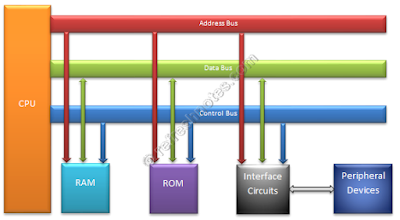Blocks of Microcomputer System
CPU consists of
- Registers for the temporary storage of information
- ALU for performing operations on this information
- Instruction decode and control unit that determine the operation to perform
- Instruction Register (IR) holds the binary code for each instruction as it is executed
- Program Counter (PC) holds the memory address of the next instruction to be executed
RAM
- Read Write memory. It is volatile.
- User program and data are loaded in to RAM for execution
ROM
- Read only memory. It is non-volatile
- Is used to hold software routines that perform input/output operations
Buses
- Unidirectional Address Bus to point memory location
- Bidirectional Data Bus to read/write data in memory
- Control Bus to generate read, write and synchronization signals
Interface Circuits
- Provide circuitry to connect peripheral devices
Peripheral Devices
- Human interface device like keyboard, mouse, printer, etc.
- Storage device like hard disk, optical disks, USB, etc.
- Control and Monitor devices
Software
- Input / Output Subroutines: Directly manipulate the hardware of the system
- Operating System for managing hardware resources
- Application Software: User interface
Fetching and Executing Instructions:
Fetching Steps
Fetching Steps
- The content of PC are placed on the address bus
- A Read signal is activated
- Data (instruction opcode) are read from RAM and placed on data bus
- The opcode is latched into the CPU’s IR
- The PC is incremented to prepare for the next fetch from memory
Executing Steps
- Decoding the opcode and generating the control signals to gate internal registers in and out the ALU and to signal ALU to perform the specified operation.
Related topics:
Microcomputer System | Numbering System | Memory Basics | Digital Logic | ASCII Code | Computer Internals | ROM and RAM Memory
List of topics: Microcomputer

No comments:
Post a Comment